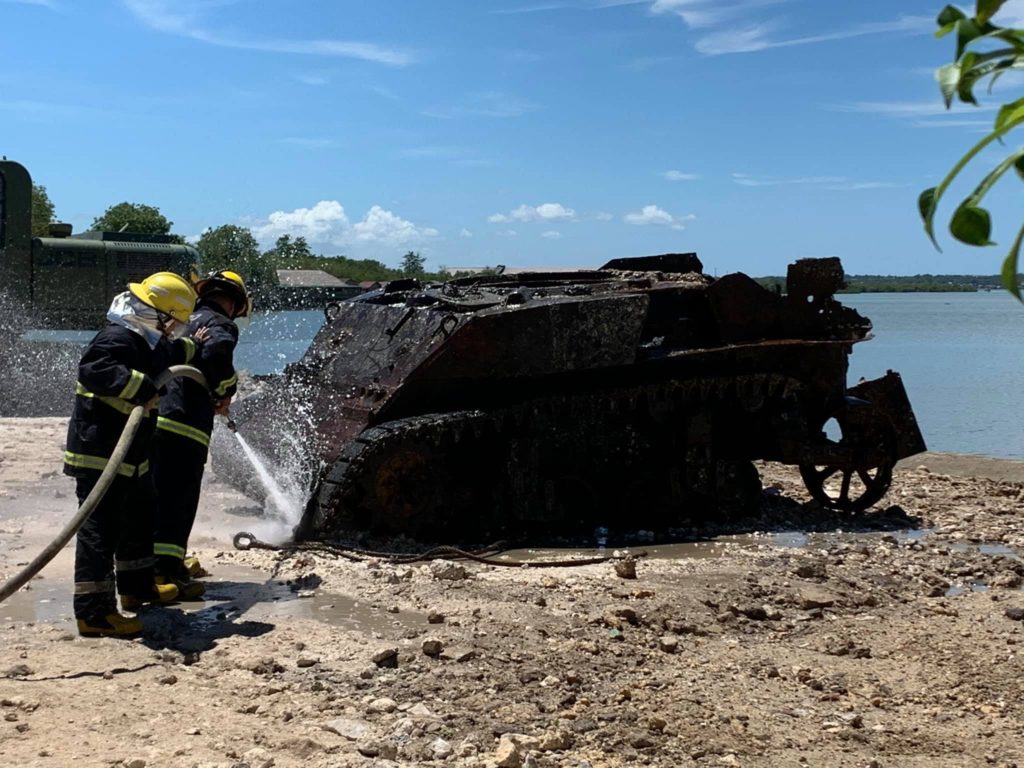
We are literally just days away from March 26, the day when, exactly 75 years ago, soldiers from the Americal Division, guided by Cebu’s famed guerrillas, began landing in Talisay from naval bases in Leyte. After the early morning landing, they began moving into Mananga River and the South Road at Pardo to begin the Liberation of Cebu.
While Cebu City would be declared free of the Imperial Japanese Forces some 23 days or so later, the story would be different in northern Cebu. Japanese forces, who survived the Battle of Leyte months earlier, had transferred to Cebu, swelling the number from the usual 2,000 to an estimated 20,000. Only slightly less than 10,000 would survive and eventually surrender in Tabogon, Catmon, Sogod and Carmen starting on August 28, 1945.
But I am getting ahead of the story. Even as Cebu City enjoyed freedom for the first time in three years and 12 days to be exact, towns in the north suffered the brunt of bedraggled Imperial Japanese soldiers, with the Americal Division harassing them.
One of those that harassed them appeared to be an M5A1 Stuart Light Tank, one of many that advanced into Japanese lines. This particular tank, according to local lore, was crossing a wooden bridge over the Dagusungan River just as a mortar was dropped from a Japanese bomber, destroying the bridge and plunging the tank, head-on and at a slight angle, to the muddy river delta.

A World War II M5A1 Stuart Light Tank is successfully extracted from the Dagusungan River of Medellin Town, 75 years since it fell into the river. |
Fast forward 75 years later and a team comprising the Engineering Battalion of the Armed Forces of the Philippines based at Medellin and the Medellin Mayor’s Office finally extracted this particular weapon of war, rescuing it from further deterioration. And now we have reason to thank that it stayed there, no matter how late in the day it came out, and even more reasons to mark the end of the war, at least in Medellin.
This tank had already been identified as an M5A1 Stuart Light Tank through an exchange of emails I made with military experts in the US in December last year, following an initial extraction attempt by the same team. The identification was made easier because photos of the tank’s turret had been emailed to me by Giles Villamor, the municipal planning and development officer of Medellin who, together with Bambi Pacquiao, the town’s tourism consultant, had met with me in my office at USC Museum late last year.
The tank’s turret, which has been extracted by Bogo-Medellin Milling Company (Bomedco) in the 1980s, sits as a centerpiece of a mini-circular park at the Bomedco compound. |
The turret had been removed during an attempt to extract the tank way back in the 1980s, an unsuccessful move by personnel from the Bogo-Medellin Sugar Milling Company (BOMEDCO) that soon spawned stories about the river’s spirits, the not-like-us (mga gili ingon nato) who refused to release what had by then become their plaything.
The gods must have favored this current attempt to extract the tank late last week, successfully ending the slow decomposition of a once-proud mobile weapon of World War II.
I saw the tank for the first time in all its rusted and barnacled glory last Sunday upon the request of Medellin Mayor Benjun Mondigo to see how it could be conserved and mounted.
It seems that as this tank began its muddy existence, affected by silt and the ebbs and flows of a river delta, no one took notice except fishermen who savored the pugapo fish that were growing inside it, as one son of a fisherman told me. He said his father and his father’s friends had spent many of their childhoods going in and out of this tank. Aside from them, no one apparently took notice.
The extracted Stuart M5A1 Light Tank is placed under a tent at Medellin town.| Jobers Reynes Bersales
That is, until the earlier-mentioned tank turret extraction. The turret, by the way, now sits at a kind of circular park where it is the centerpiece inside the BOMEDCO compound, also just about a kilometer away from the river, and entreaties will have to be made by the local government of Medellin for both tank and its turret to reunite soon, in time for the liberation of Medellin.
Two stories about tank
At least two stories need to be told about this tank which I noted as I prepared a condition report. First, sometime between the 1980s extraction attempt and this present one, someone took a blowtorch to the site and started removing sections of the rear, the portion that would often appear during low tide I suppose.
Even a large section of an inch-thick plating on the tank’s right side was not spared and perhaps the Cadillac engine, which was also located at the rear portion, unless it was removed by American soldiers after abandoning the tank. All this was apparently going on unbeknownst to just about everyone who knew that this tank was there beside a concrete bridge.
Second is another tank story from my former student and board mate, Christopher Palacio, formerly of Danao City but now based in Canada, who sent me a private message on my Facebook page. According to him, there is a family lore about his maternal uncle, Reuben Lao, a former USAFFE soldier-turned-guerrilla and an accomplished mechanic who married a Jumao-as from Medellin.
Reuben had one day gone to Medellin to repair a tank that had stopped moving and was able to repair it. After the war ended, he left the tank in Medellin. I do not know if this tank is the same one that somehow fell on the Dagusungan River but if this is a different one, then there should be another tank story in Medellin waiting to be unraveled.
For the moment, much work needs to be done to conserve whatever is left of it, and I hear that the metal plating that was removed in that past can still be retrieved and put back. The ultimate plan I should think is not just a plinth where this tank would stand but also a small but important information center of sorts, explaining not just the tank and its own story but about the war as it happened in northern Cebu.
This is made more feasible as the Medellin Dockside, a kind of seaside food court, has long been in existence a few meters from where this tank fell. We have thus one more reason not to forget the past lest we repeat it and enjoy the breeze too as we ponder on the future hopefully without Covid-19.

